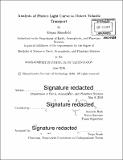Analysis of Pluto's light curve to detect volatile transport
Author(s)
Mansfield, Megan (Megan L.)
DownloadFull printable version (5.774Mb)
Other Contributors
Massachusetts Institute of Technology. Department of Earth, Atmospheric, and Planetary Sciences.
Advisor
Amanda Bosh.
Terms of use
Metadata
Show full item recordAbstract
Changes in the volatile distribution on Pluto's surface and in its atmosphere are expected to occur over its orbital path due to varying surface insolation[14]. To investigate these changes, a model was created to synthesize light curves of Pluto, given the viewing geometry and surface albedo distribution. Using an initial surface albedo distribution based on images taken by New Horizons, changes in the light curve mean magnitudes and amplitudes over time were compared to the smallest magnitude changes detectable by a variety of telescopes. The model predicts that yearly observations on a large ground-based telescope, such as the 6.5-meter Magellan telescopes, could observe magnitude changes due to both changes in viewing geometry and surface albedo changes. The model can be compared to future observations to estimate how much surface albedo change is necessary to produce the observed light curves, and can therefore be used to link observational data to physical changes on Pluto's surface and the methods of volatile transport responsible for those changes.
Description
Thesis: S.B., Massachusetts Institute of Technology, Department of Earth, Atmospheric, and Planetary Sciences, 2016. Cataloged from PDF version of thesis. Includes bibliographical references (pages 65-66).
Date issued
2016Department
Massachusetts Institute of Technology. Department of Earth, Atmospheric, and Planetary SciencesPublisher
Massachusetts Institute of Technology
Keywords
Earth, Atmospheric, and Planetary Sciences.